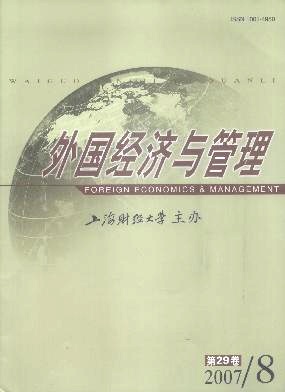CEO任期与企业绩效关系模型探讨
外国经济与管理 2007 年 第 29 卷第 08 期, 页码:45 - 50
摘要
参考文献
摘要
本文总结了CEO任期与企业绩效间关系经典理论模型的要旨及成因,概括了以企业与环境匹配度、CEO变革态度和高管团队风险倾向等为中间变量的间接关系模型,并指出了现有研究在方法和产业环境因素界定上的不足;然后,在此基础上提出了CEO任期与企业绩效关系的综合理论模型,强调指出了产业市场因素对CEO任期与企业绩效关系的调节作用;最后对CEO任期与企业绩效关系模型在我国产业市场环境下的研究前景进行了展望。
[1]Rosenstein,J.Why don’t US boards gets more involved in strategy?[J].Long Range Planning,1987,20(3):30-34.
[2]Hambrick,D C,and Mason,P.Upper echelons:The organization as a reflection of its top managers[J].Academy of Management Re-view,1984,9(2):193-206.
[3]Simsek,Zeki.CEO tenure and organizational performance:Testing a nonlinear intervening model[R].Academy of Management BestConference Paper,BPS,2004:1-7.
[4]Hambrick,D C,Geletkanycz,M A,and Fredrickson,J W.Top executive commitment to the status quo:Some tests of its determinants[J].Strategic Management Journal,1993,14(6):401-418.
[5]Bergh,Donald D.Executive retention and acquisition outcomes:A test of opposing views on the influence of organizational tenure[J].Journal of Management,2001,27(5):603-622.
[6]Hambrick,D C,and Fukutomi,G.The seasons of a CEO’s tenure[J].Academy of Management Review,1991,16(4):719-742.
[7]Henderson,A D,Miller,D,and Hambrick,D C.How quickly do CEOs become obsolete?Industry dynamism,CEO tenure,and compa-ny performance[J].Strategic Management Journal,2006,27(5):447-460.
[8]Tushman,M L,and Romanelli,E.Organizational evolution:A metamorphosis model of convergence and reorientation[A].in Cum-mings,L L,and Staw,B M(Eds.).Research in organizational behavior[C].Greenwich:JAI Press,1985:171-222.
[9]Groysberg,Boris,McLean,Andrew N,and Nohria,Nitin N.Are leaders portable?[J].Harvard Business Review,2006,84(5):92-100.
[10]Nadler,David A.The CEO’s 2nd act[J].Harvard Business Review,2007,85(1):66-72.
[11]Miller,D.Stale in the saddle:CEO tenure and the match between organization and environment[J].Management Science,1991,37(1):34-52.
[12]Meyer,Marshall W.Leadership and organizational structure[J].The American Journal of Sociology,1975,81(3):514-542.
[13]Mintzberg,R.Power in and around organizations[M].Englewood Cliffs:Prentice Hall,1983.
[14]Katz,R.Project communication and performance:An investigation into the effects of group longevity[J].Administrative ScienceQuarterly,1982,27(1):81-104.
[15]Miller,D,and Shamsie,J.Learning across the life cycle:Experimentation and performance among the Hollywood studio heads[J].Strategic Management Journal,2001,22(8):725-745.
[16]Lumpkin,G T,and Dess,G G.Clarifying the entrepreneurial orientation construct and linking it to performance[J].Academy of Man-agement Review,1996,21(1):135-172.
[17]Geddes,R,and Vinod,F.CEO tenure,board composition,and regulation[J].Journal of Regulatory Economics,2002,21(2):217-235.
[18]Wu,Sinbin,Levitas,Edward,and Priem,Richard L.CEO tenure and company invention under differing levels of technological dyna-mism[J].Academy of Management Journal,2005,48(5):859-873.
[2]Hambrick,D C,and Mason,P.Upper echelons:The organization as a reflection of its top managers[J].Academy of Management Re-view,1984,9(2):193-206.
[3]Simsek,Zeki.CEO tenure and organizational performance:Testing a nonlinear intervening model[R].Academy of Management BestConference Paper,BPS,2004:1-7.
[4]Hambrick,D C,Geletkanycz,M A,and Fredrickson,J W.Top executive commitment to the status quo:Some tests of its determinants[J].Strategic Management Journal,1993,14(6):401-418.
[5]Bergh,Donald D.Executive retention and acquisition outcomes:A test of opposing views on the influence of organizational tenure[J].Journal of Management,2001,27(5):603-622.
[6]Hambrick,D C,and Fukutomi,G.The seasons of a CEO’s tenure[J].Academy of Management Review,1991,16(4):719-742.
[7]Henderson,A D,Miller,D,and Hambrick,D C.How quickly do CEOs become obsolete?Industry dynamism,CEO tenure,and compa-ny performance[J].Strategic Management Journal,2006,27(5):447-460.
[8]Tushman,M L,and Romanelli,E.Organizational evolution:A metamorphosis model of convergence and reorientation[A].in Cum-mings,L L,and Staw,B M(Eds.).Research in organizational behavior[C].Greenwich:JAI Press,1985:171-222.
[9]Groysberg,Boris,McLean,Andrew N,and Nohria,Nitin N.Are leaders portable?[J].Harvard Business Review,2006,84(5):92-100.
[10]Nadler,David A.The CEO’s 2nd act[J].Harvard Business Review,2007,85(1):66-72.
[11]Miller,D.Stale in the saddle:CEO tenure and the match between organization and environment[J].Management Science,1991,37(1):34-52.
[12]Meyer,Marshall W.Leadership and organizational structure[J].The American Journal of Sociology,1975,81(3):514-542.
[13]Mintzberg,R.Power in and around organizations[M].Englewood Cliffs:Prentice Hall,1983.
[14]Katz,R.Project communication and performance:An investigation into the effects of group longevity[J].Administrative ScienceQuarterly,1982,27(1):81-104.
[15]Miller,D,and Shamsie,J.Learning across the life cycle:Experimentation and performance among the Hollywood studio heads[J].Strategic Management Journal,2001,22(8):725-745.
[16]Lumpkin,G T,and Dess,G G.Clarifying the entrepreneurial orientation construct and linking it to performance[J].Academy of Man-agement Review,1996,21(1):135-172.
[17]Geddes,R,and Vinod,F.CEO tenure,board composition,and regulation[J].Journal of Regulatory Economics,2002,21(2):217-235.
[18]Wu,Sinbin,Levitas,Edward,and Priem,Richard L.CEO tenure and company invention under differing levels of technological dyna-mism[J].Academy of Management Journal,2005,48(5):859-873.
引用本文
许晓明, 李金早. CEO任期与企业绩效关系模型探讨[J]. 外国经济与管理, 2007, 29(8): 45–50.
导出参考文献,格式为:





 7906
7906  941
941

